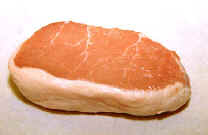
Pork Loin showing fat cap and marbling
Fat and Marbling
 |
|
Pork Loin showing fat cap and marbling |
Of all the factors that go into the measurement of the quality of meat, fat is the most important. The amount, the distribution, and the condition of an animal's fat are essential ingredients in the mix of cost, cutability, and palatability of meats. The total amount of fat may range from as little as 5 percent on a very lean animal to as much as 35 percent on a very fat animal. The fat on the outside of an animal's muscles is called cover. The fat which lies between the bundles of muscle fibers is called marbling. The amount of marbling in the meat and between the connective tissues is a very important factor in meat since it creates the bite or chewability looked for in cooked meat.
Meat in the United States is usually well marbled because the animals are finished on specialized grain feeds which convert rapidly to fat. This is in marked contrast to South American or Australian meat which is usually raised only on grazing grasses and is, therefore, less fatty and much tougher to chew.
Fat accounts for much of the flavor of meat because a fat subcomponent, esters, imparts and enhances the typical "meat" flavors. The type of feed, again, reflects in the type of fat and the eventual flavor of the meat. Thus, the regional preference for "corn-fed" or grain-fed pork, for example.
The more fat on an animal, the less lean. This factor means that the more fat an animal has in ratio to its lean, the higher the cost of that lean. Prime Beef, for example, is very well marbled and has a thick fat cover and thus costs much more than Choice, Good, or the lesser grades of meat.
The positive nutritive value of meat is in the lean tissue and not in the fat.
The food value of a pound of lean is the same whether it is from costly Prime or from inexpensive Commercial. As mentioned earlier, the means of cooking has much to do with the chewability and, therefore, the smart operator will buy according to need.
Prime-style meat should be purchased only for the "carriage trade" business of expensive chop operations where the finest quality is called for and paid for by a clientele that can afford it.